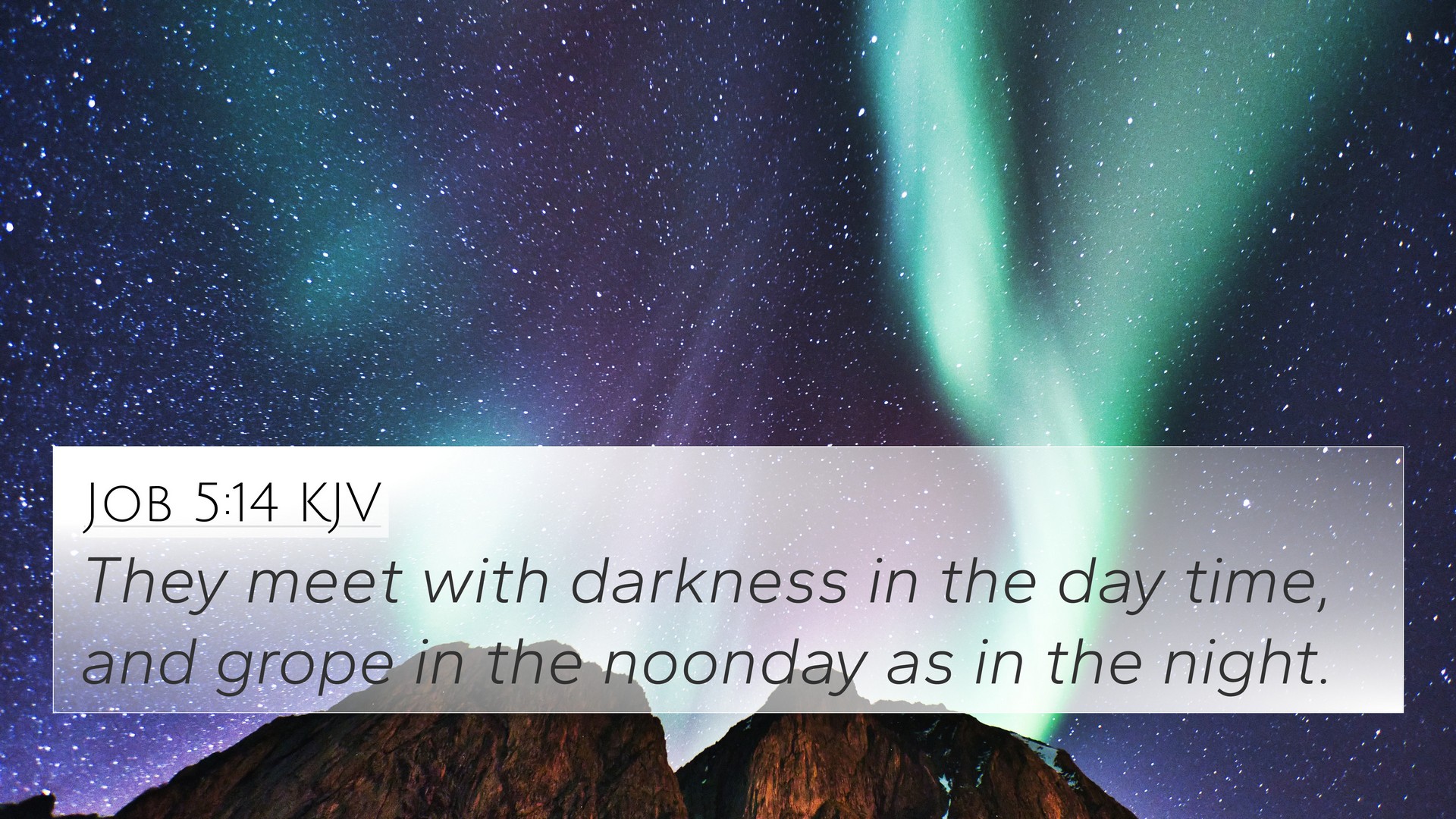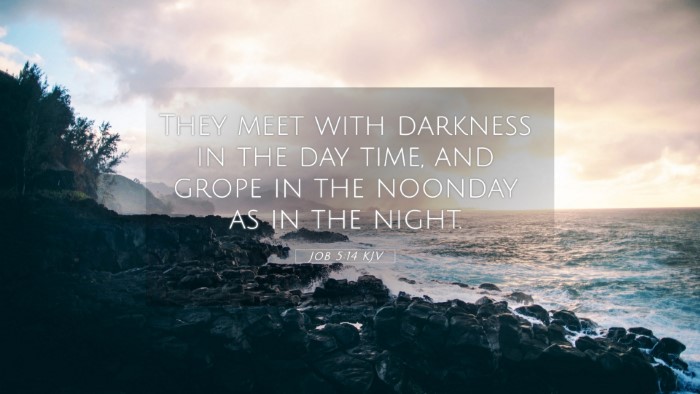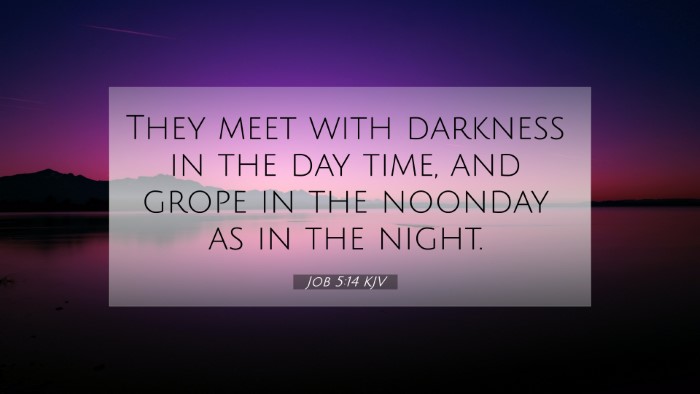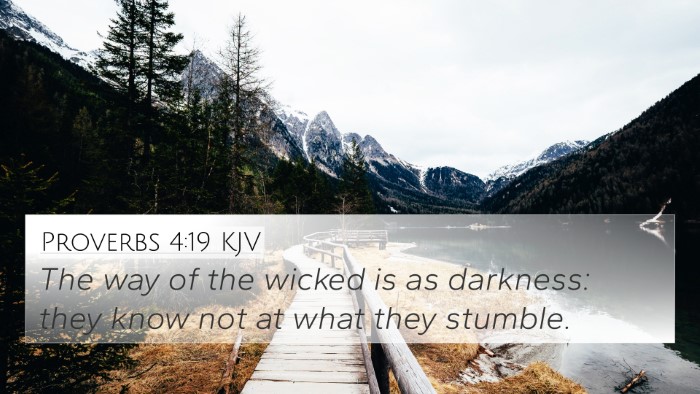Old Testament
Genesis Exodus Leviticus Numbers Deuteronomy Joshua Judges Ruth 1 Samuel 2 Samuel 1 Kings 2 Kings 1 Chronicles 2 Chronicles Ezra Nehemiah Esther Job Psalms Proverbs Ecclesiastes Song of Solomon Isaiah Jeremiah Lamentations Ezekiel Daniel Hosea Joel Amos Obadiah Jonah Micah Nahum Habakkuk Zephaniah Haggai Zechariah MalachiJob 5:14 Similar Verses
Job 5:14 Cross References
They meet with darkness in the day time, and grope in the noonday as in the night.
Uncover the Rich Themes and Topics of This Bible Verse
Listed below are the Bible themes associated with Job 5:14. We invite you to explore each theme to gain deeper insights into the Scriptures.
Job 5:14 Cross Reference Verses
This section features a detailed cross-reference designed to enrich your understanding of the Scriptures. Below, you will find carefully selected verses that echo the themes and teachings related to Job 5:14 KJV. Click on any image to explore detailed analyses of related Bible verses and uncover deeper theological insights.
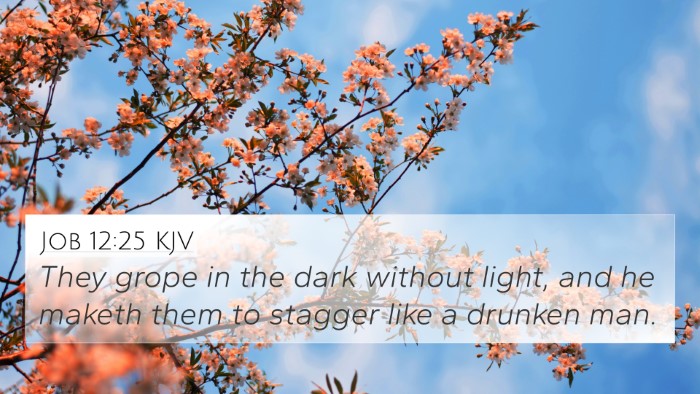
Job 12:25 (KJV) »
They grope in the dark without light, and he maketh them to stagger like a drunken man.
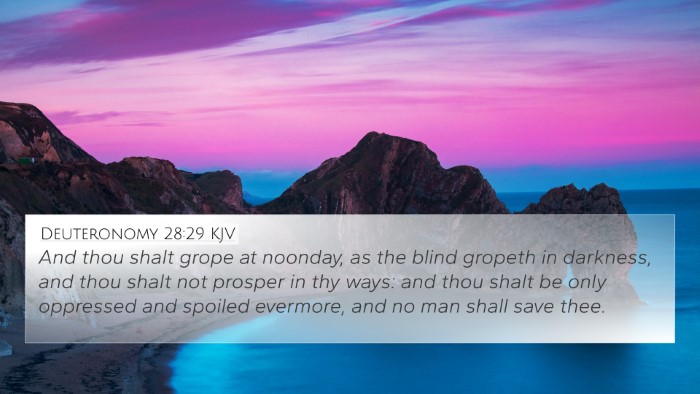
Deuteronomy 28:29 (KJV) »
And thou shalt grope at noonday, as the blind gropeth in darkness, and thou shalt not prosper in thy ways: and thou shalt be only oppressed and spoiled evermore, and no man shall save thee.
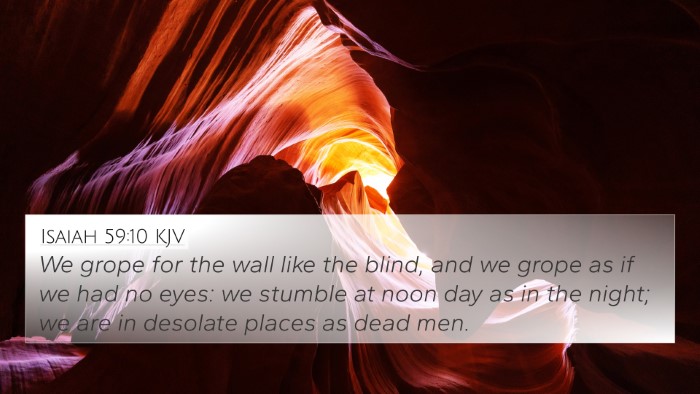
Isaiah 59:10 (KJV) »
We grope for the wall like the blind, and we grope as if we had no eyes: we stumble at noon day as in the night; we are in desolate places as dead men.
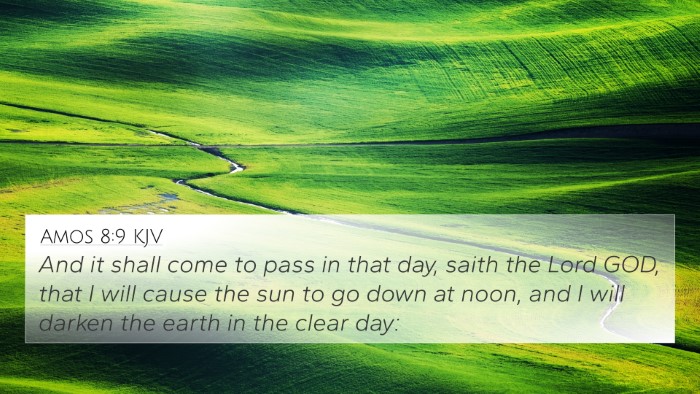
Amos 8:9 (KJV) »
And it shall come to pass in that day, saith the Lord GOD, that I will cause the sun to go down at noon, and I will darken the earth in the clear day:
Job 5:14 Verse Analysis and Similar Verses
Understanding Job 5:14
Job 5:14 states: "They meet with darkness in the daytime, and grope in the noonday as in the night." This verse speaks to the theme of Divine justice and the experiences of suffering. The context of this verse is rooted in the discourse of Eliphaz, who speaks of the trials and tribulations that Job faces, and the general human condition in relation to God’s ways.
Interpretation Overview
The verse serves as a metaphor illustrating the idea of spiritual blindness or confusion, particularly in the midst of trials. Although it occurs in the daylight—a symbol of understanding and clarity—there are individuals so consumed by despair that they operate fundamentally as if they were in darkness.
Insights from Public Domain Commentaries
-
Matthew Henry:
Henry emphasizes the sovereignty of God and how He allows suffering, pointing out that people often remain unaware of the divine workings around them. This spiritual darkness refers to their inability to see God’s hand even when it is seemingly active in their lives.
-
Albert Barnes:
Barnes elaborates on the struggle of the human condition, noting how people may find themselves lost in despair despite the light of day. He indicates that this may hint at a deeper moral or spiritual failings that prevent clarity of vision.
-
Adam Clarke:
Clarke focuses on the metaphorical meanings, interpreting 'day' and 'noon' as indicative of times in life when one should have clarity and hope. He observes that this darkness represents a lack of hope or peace that can only come through a relationship with God.
Connections to Other Bible Verses
Job 5:14 can be cross-referenced with several other verses that hold thematic connections regarding suffering, spiritual blindness, and divine justice:
- Psalms 69:23: "Let their eyes be darkened, that they see not; and make their loins continually to shake."
- Isaiah 59:10: "We grope for the wall like the blind, and we grope as if we had no eyes: we stumble at noonday as in the night; we are in desolate places as dead men."
- Romans 1:21: "Because that, when they knew God, they glorified him not as God, neither were thankful; but became vain in their imaginations, and their foolish heart was darkened."
- 2 Corinthians 4:4: "In whom the god of this world hath blinded the minds of them which believe not, lest the light of the glorious gospel of Christ, who is the image of God, should shine unto them."
- Lamentations 3:2: "He hath led me, and brought me into darkness, but not into light."
- Micah 7:8: "Rejoice not against me, O mine enemy: when I fall, I shall arise; when I sit in darkness, the LORD shall be a light unto me."
- 1 John 2:11: "But he that hateth his brother is in darkness, and walketh in darkness, and knoweth not whither he goeth, because that darkness hath blinded his eyes."
Thematic Cross-References
This exploration of cross-references demonstrates the interconnectedness of scripture, revealing a broader theological narrative about the human experience of suffering and the contrasting nature of divine clarity and justice:
- Thematic Connection: The struggle between light and darkness is a recurring theme in biblical literature. Understanding the nature of spiritual blindness can enhance the comprehension of divine encounters.
- Challenges of Life: References in Job, Isaiah, and Lamentations highlight the existential challenges individuals face, particularly in their journeys through suffering.
- The Role of God: Many of these verses underscore the active role of God in guiding and providing light amidst dark circumstances.
- Moral Responsibility: There is also an implication that moral action (or inaction) can lead to a state of spiritual blindness, discussed in Romans and 1 John.
Tools for Deepening Understanding
Utilizing tools for Bible cross-referencing can provide profound insights into the interconnected scriptures. Here are some methods for effective study:
- Bible Concordance: Look up keywords to find related verses in various books.
- Bible Cross-Reference Guide: Use thematic indexes to locate verses that correspond to specific topics.
- Cross-Reference Bible Study: Create your own verses list by linking thematic ideas across different books and authors.
- Bible Chain References: Follow the chains of thought from one scripture to another, providing a cohesive narrative.
Conclusion
Job 5:14 is a profound verse that resonates with the realities of human suffering and spiritual blindness. By engaging with public commentaries and employing tools for cross-referencing, readers can unveil deeper meanings and contextual connections within the Bible. Recognizing these connections can enrich one's understanding of both individual verses and the overarching messages of scripture.
